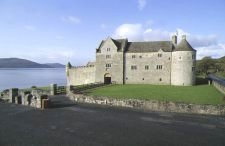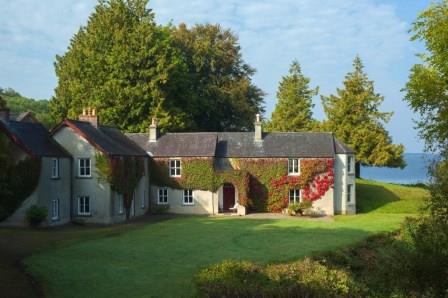Clogherevagh
Houses within 5km of this house
Displaying 14 houses.
Houses within 5km of Clogherevagh
Displaying 14 houses.
| House name | Description | |
|---|---|---|
| Ellenville or Ardaghowen | The first edition OS Map suggests the house on this site was known at that time as Ellenville. It is now known as Ardaghown, still extant but derelict and was under renovation in 2006. McTernan indicates that it was originally built as a dower house for the Wynne estate. In the 1850s it was held by Owen Wynne from Capt. James Martin and valued at £35. |

|
| Percymount | At the time of Griffith's Valuation John Wynne held this property at Kiltycahill, when it was described as "Painter's house" and valued at £5. The property had been owned by the Gethin family until its sale in the Encumbered Estates Court in the early 1850s. McTernan states that races were frequently held on the lawn at Percymount between the 1870s and the 1940s. The house is now in a derelict condition. | |
| Hazelwood | Hazelwood was designed for Owen Wynne by the architect Richard Castle and built between 1720 and 1740. Reverend William Henry's account of Sligo in 1739 contains a detailed account of the house. Wilson describes it in 1786 as "a fine and elegant seat". It remained the home of the Wynne family for 200 years. At the time of Griffith's Valuation it was owned by John Wynne and was valued at £120. The estate was sold to the Land Commission in the 1920s and the house has had various uses including army accommodation, psychiatric hospital and more latterly, part of an industrial building. Though neglected it survives intact. |

|
| Cleveragh | Capt. James Martin was the lessor of a property valued at £18 at Cleaveragh Demesne, barony of Carbury at the time of Griffith's Valuation. It was being leased by Robert Wilson. It continued in Martin ownership until the twentieth century though frequently occupied by tenants. The house and demesne were eventually bought by Sligo Borough Council with the intention of creating a town park though this was only partially realised. The house was demolished in 1999. | |
| Parke's Castle | This castle was built by Capt. Roger Parke, incorporating an old O'Rourke castle, probably in the first or second decades of the 17th century. This property eventually came into the possession of the Gore family through the marriage of Anne Parke to Sir Francis Gore. |

|
| Newtown Manor | A house built after the publication of the First Ordnance Survey map. John James Whyte held this property in fee at the time of Griffith's Valuation, when itwas valued at £12. Slater notes that it was the residence of Captain Edward T. Pottinger in 1894. In 1906 Charles B. Whyte was the owner of the house at Carrickfad valued at £22. It is no longer extant. | |
| Sriff Cottage | Sriff Cottage was associated with the Palmer family and possibily originally used as a hunting lodge. At the time of Griffith's Valuation, it was being leased from the Lane Fox estate by Henry Palmer and was valued at £4. This house is still extant and in 2015 was offered for sale. |

|
| Ballyglass House | Ballyglass House was in the possession of the Rev. William Gillmor at the time of the sale of lands in November 1854. There were two substantial houses in Ballyglass townland at the time of Griffith's Valuation in 1856. One, valued at £16, was leased from John Wynne by Rev. Gillmor, while the second was being leased from him by James Duncan. McTernan notes that it was purchased from Gillmor by Peter O'Connor and used by members of that family up until the twentieth century. Slater records it as his seat in 1894. It is still extant and occupied. |

|
| Faughts Cottage | At the time of Griffith's Valuation, Phillip Parke was leasing a property at Faughts, barony of Carbury, valued at £7, from John Wynne. This appears to be the house described on both the First and 25-inch edition Ordnance Survey maps as "Faughts Cottage". A house is still extant at the site. | |
| AbbeyView | At the time of Griffith's Valuation, Alexander Phillips was leasing a house valued at almost £14 at Abbeyquarter North, barony of Carbury, from the Cooper estate. McTernan states that it was built in the later eighteenth century and described in 1878 "as a beautifully situated villa residence with attractive grounds". The Phillips family continued in residence until the 1860s after which it was occupied by a succession of owners until the 1990s when it was sold to the Electricity Supply Board who demolished the house. | |
| Holywell | In his 1802 description of the Wynne estate McParlan mentions that Rev. Richard Wynne was about to build at Holywell, along the shore of Lough Gill. At the time of Griffith's Valuation John Wynne was leasing the house in Cloghermore to James Patterson when it was valued at almost £7. In 1894, Slater refers to it as the seat of Captain Gethin. This house is still extant and has recently been extensively renovated. |

|
| Colgagh House | Edward Homan was leasing a property valued at £18 from the Ffolliott estate at Cogagh, parish of Calry at the time of Griffith's Valuation. McTernan writes that the Homans continued in residence until the 1880s. Colgagh House is still extant and occupied. |

|
| Cairnsfoot | McTernan indicates that Maj. De Bromhead is the reputed builder of Cairnsfoot, probably in the early decades of the nineteenth century, when he leased the lands from the Cooper estate. He had married Judith Wood in 1823. In the 1840s he returned to England and the house was let to a number of different families, notably the O'Connors. In 2004 it was partially destroyed by fire and subsequently demolished. | |
| Belvoir (Sligo) | Wilson refers to Belvoir, situated on the other side of the Garavogue river from Hazelwood, as the seat of Mr. Ormsby in 1786. By the time of Griffith's Valuation, the property here is held by John Wynne and referred to as "a servant's house", valued at £2 15s. Buildings are still extant at the site. |

